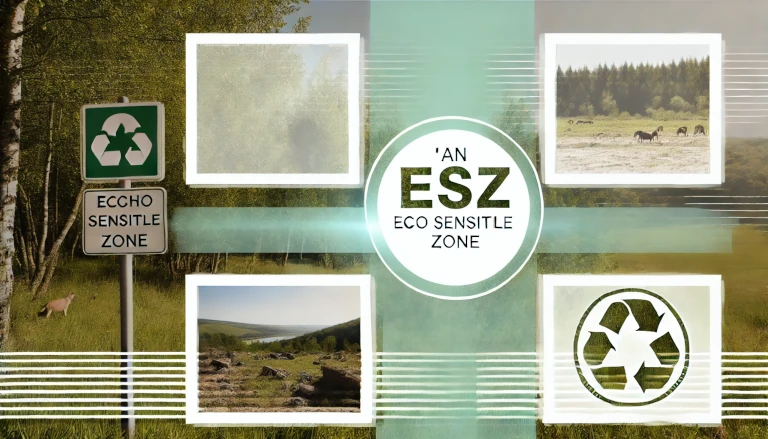An Eco Sensitive Zone (ESZ), also known as an ecological buffer zone, is an area around protected areas such as national parks, wildlife sanctuaries, and biodiversity hotspots that aims to minimize human impact on the environment. These zones act as transition areas between highly protected areas and regions of human activity. ESZs are essential for maintaining the ecological balance, conserving wildlife, and protecting biodiversity.
What is an Eco Sensitive Zone? 🏞️
An Eco Sensitive Zone is a region that surrounds a protected area, such as a wildlife sanctuary or national park, and is intended to limit the impact of human activities on the surrounding environment. These zones function as buffer zones, where certain activities are restricted or regulated to prevent any negative effects on the biodiversity within the protected areas. The government of India, for instance, has demarcated several ESZs to safeguard sensitive ecosystems from industrial and urban expansion.
Key Features of an Eco Sensitive Zone:
- Acts as a protective buffer around fragile ecosystems.
- Regulates human activities to ensure sustainable development.
- Protects biodiversity by minimizing environmental degradation.
Why Are Eco Sensitive Zones Important? 🌱
Eco Sensitive Zones are crucial for several reasons:
- Biodiversity Conservation: They help protect endangered species and ecosystems by creating a buffer that minimizes human interference.
- Environmental Protection: By regulating activities such as deforestation, mining, and industrialization, ESZs prevent ecological damage, soil erosion, and pollution.
- Sustainable Development: ESZs encourage sustainable land use practices that allow for economic development while protecting the environment.
- Climate Regulation: Eco Sensitive Zones help preserve forests and wetlands, which play a critical role in climate regulation and carbon sequestration.
How Are Eco Sensitive Zones Designated? 🗺️
Eco Sensitive Zones are typically designated by government authorities, such as the Ministry of Environment, Forest and Climate Change in India. The process involves:
- Identifying Protected Areas: Areas such as national parks, wildlife sanctuaries, and biodiversity hotspots are first identified as critical habitats.
- Buffer Zone Demarcation: A certain radius around these protected areas is designated as an Eco Sensitive Zone based on ecological criteria, human activity, and conservation needs.
- Legal Notifications: Once the ESZ is identified, legal frameworks are put in place to restrict or regulate activities within the zone.
What Activities Are Restricted in an Eco Sensitive Zone? 🚧
The activities allowed within an Eco Sensitive Zone depend on its classification, but typically, activities that could harm the environment are regulated or prohibited, including:
- Mining: Extractive activities such as mining are highly regulated due to their potential to cause environmental degradation.
- Industrial Activities: Factories and industries that pollute the air, water, or soil are either restricted or banned in these zones.
- Deforestation: Large-scale cutting of trees is prohibited to protect forest cover and wildlife habitats.
- Construction: Development projects, such as large infrastructure or tourism projects, are regulated to minimize the impact on local ecosystems.
Certain activities like sustainable agriculture, eco-tourism, and traditional livelihoods may be allowed if they follow strict guidelines.
When Are Eco Sensitive Zones Implemented? 📅
Eco Sensitive Zones are implemented when the government identifies a need to protect an ecosystem that is under threat from industrialization, urbanization, or other forms of human activity. The designation process can take years as it involves environmental impact assessments, stakeholder consultations, and regulatory approvals.
Example of Implementation:
India has established numerous ESZs around its protected areas, such as the Western Ghats, a UNESCO World Heritage site known for its rich biodiversity.
How Much Area Is Covered by Eco Sensitive Zones? 🌍
The size of an Eco Sensitive Zone varies depending on the area it surrounds. Generally, ESZs can extend from 500 meters to 10 kilometers around the boundaries of the protected area. The exact size is determined based on environmental factors, such as the ecological sensitivity of the region and the level of human activity in the surrounding area.
Advantages of Eco Sensitive Zones 🌟
- Biodiversity Protection: ESZs serve as critical areas for conserving species and ecosystems that may otherwise be impacted by human activities.
- Climate Mitigation: By preserving forests and other natural areas, Eco Sensitive Zones help mitigate climate change by sequestering carbon and regulating temperatures.
- Promotes Sustainable Practices: ESZs encourage communities and industries to adopt eco-friendly practices that benefit both the economy and the environment.
- Reduces Human-Wildlife Conflicts: By maintaining buffer zones between human settlements and wildlife habitats, ESZs help reduce conflicts such as crop damage or attacks on livestock.
Disadvantages of Eco Sensitive Zones ⚖️
- Economic Limitations: Restrictions on industrial activities in ESZs can limit local economic development, leading to concerns among local communities about loss of livelihood opportunities.
- Conflict with Development Goals: Eco Sensitive Zones may hinder infrastructure projects like road construction or urban expansion, creating friction between environmentalists and developers.
- Challenges in Enforcement: Ensuring compliance with regulations within Eco Sensitive Zones can be difficult, particularly in areas with limited governance or monitoring.
Cost Benefits of Eco Sensitive Zones 💸
While the economic restrictions in Eco Sensitive Zones may limit certain types of development, the long-term benefits outweigh the costs:
- Tourism Revenue: Eco-tourism and sustainable travel can generate significant revenue for local communities while maintaining environmental integrity.
- Reduced Environmental Cleanup Costs: By preventing activities that lead to pollution or habitat destruction, governments save money on environmental restoration and mitigation.
- Improved Public Health: Cleaner air, water, and reduced deforestation contribute to healthier living environments, lowering healthcare costs associated with pollution-related diseases.
Protecting Nature Through Eco Sensitive Zone 🌳
Eco Sensitive Zones are a vital tool for protecting fragile ecosystems and promoting sustainable development. By regulating human activities in these zones, we can safeguard biodiversity, mitigate climate change, and ensure that future generations benefit from a healthy environment. The challenge lies in balancing conservation with development, but the long-term advantages of ESZs make them a critical component of environmental policy.
By designating Eco Sensitive Zones, we can protect vital ecosystems, promote sustainable development, and ensure a balance between human activity and environmental conservation. 🌍
Read this in Marathi at पर्यावरण-संवेदनशील क्षेत्र (ESZ): महत्त्व, फायदे आणि आव्हाने
Discover more from Green Ecosystem - Renewable Energy, Agriculture, and Environmental Sustainability
Subscribe to get the latest posts sent to your email.

